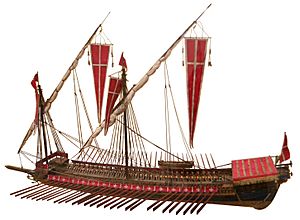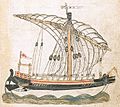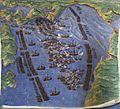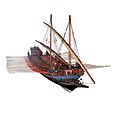Galley facts for kids

A galley is a special kind of ship that uses rowing to move through the water. These ships were very important for travel, trade, and fighting at sea for thousands of years. The first galleys were used in Ancient Egypt during the Old Kingdom, which was around 2700 to 2200 BCE.
What is a Galley?
Galleys are long, narrow ships that are mainly powered by people rowing with oars. They also often had sails to help them move when the wind was good. This mix of oars and sails made galleys very flexible. They could move even when there was no wind, which was a big advantage in ancient and medieval times.
How Galleys Were Designed
Galleys were built to be fast and easy to steer. Their long, slim shape helped them cut through the water quickly. They had many oars, sometimes arranged in rows or levels. The people who rowed them were called oarsmen or rowers.
Oars and Rowers
The number of oars and rowers on a galley could vary a lot. Some smaller galleys might have only a few dozen rowers, while larger warships could have hundreds. The rowers often sat on benches, pulling long oars that went out through holes in the side of the ship.
Sails on Galleys
Even though rowing was the main way galleys moved, most also had one or more sails. These sails were usually square or lateen (triangular) shaped. They were used when the wind was blowing in the right direction, saving the rowers' energy. However, during battles, the sails were often taken down so the rowers could maneuver the ship quickly.
The History of Galleys
Galleys have a very long history, dating back thousands of years. They were used by many different civilizations around the Mediterranean Sea and beyond.
Ancient Galleys
The earliest galleys were simple boats used by the ancient Egyptians. Later, the Greeks and Romans developed more advanced galleys.
Greek and Roman Galleys
The trireme was a famous type of Greek and Roman galley. It had three rows of oars on each side, one above the other. This design allowed for many rowers in a relatively small space, making the ship very powerful. These ships were crucial in famous naval battles, like the Battle of Salamis.
In ancient times, galleys were the main warships. They would try to ram enemy ships with a strong metal point at the front called a ram. They also carried soldiers who would try to board enemy ships and fight hand-to-hand.
Medieval and Early Modern Galleys
Galleys continued to be important ships throughout the Middle Ages and into the early modern period.
Venetian Galleys
The Venetians were famous for their galleys, which they used for both trade and war. Their "great galleys" were large trading ships that could carry valuable goods across long distances. They also had "galleys subtle" which were faster and used for military purposes.
The Ottoman Empire
The Ottoman Empire also relied heavily on galleys for their navy. They fought many battles against European powers using large fleets of galleys. One of the most famous galley battles was the Battle of Lepanto in 1571, where a large Christian fleet fought against the Ottoman navy.
Decline of Galleys
By the 17th and 18th centuries, galleys started to become less important. This was mainly because of improvements in sailing ship design and the development of more powerful cannons.
Rise of Sailing Ships
Sailing ships, like frigates and ships of the line, became much larger and could carry many more heavy cannons. They were also more efficient for long voyages across oceans because they didn't need hundreds of rowers. Galleys, with their many rowers, were expensive to operate and maintain.
Last Uses of Galleys
Even though they were becoming outdated, some navies still used galleys for a while, especially in the calm waters of the Mediterranean Sea or for coastal defense. They were still useful for quickly moving troops or supplies in certain situations. However, by the 19th century, galleys were mostly replaced by sailing ships and later by steam-powered vessels.
Images for kids
-
The English-built Charles Galley, a "galley frigate" built in the 1670s. It was not a "true" galley, but the term still became part of its name due to its oars.
-
Watercolor of United States ships at the Battle of Valcour Island, depicting several "row galleys"; similar function, but based on very different designs from Mediterranean galleys.
-
Assyrian warship, a bireme with pointed bow. 700 BC
-
A Roman naval bireme in a relief from the Temple of Fortuna Primigenia in Praeneste, (Palastrina) built c. 120 BC, (in the Museo Pio-Clementino).
-
Two compact liburnians used by the Romans in the campaigns against the Dacians in the early 2nd century AD; relief from Trajan's Column, c. 113 AD.
-
Venetian great galley with three sails taking pilgrims to Jerusalem (Conrad Grünenberg 1486/7).
-
Painting of the Battle of Haarlemmermeer of 1573 by Hendrick Cornelisz Vroom. Note the use of small sailing vessels and galleys on both sides.
-
The Battle of Lepanto in 1571, naval engagement between allied Christian forces and the Ottoman Turks.
-
Dutch ships ramming Spanish galleys in the Battle of the Narrow Seas, October 1602.
-
Illustration of an Egyptian rowed ship of c. 1250 BC. Due to a lack of a proper keel, the vessel has a truss, a thick cable along its length, to prevent it from losing its shape.
-
14th-century painting of a light galley, from an icon now at the Byzantine and Christian Museum at Athens
-
The ram bow of the trireme Olympias, a modern full-scale reconstruction of a classical Greek trireme.
-
The Byzantine fleet repels the Rus' attack on Constantinople in 941. The Byzantine dromons are rolling over the Rus' vessels and smashing their oars with their spurs.
-
Byzantine ship attacking with Greek fire. Madrid Skylitzes manuscript, 11th century.
-
Contemporary depiction of the Battle of Lepanto in 1571 that shows the strict formations of the opposing fleets. Fresco in the Gallery of Maps in Vatican Museum.
-
The Galley Subtle, one of the very few Mediterranean-style galleys employed by the English. This illustration is from the Anthony Roll (c. 1546) and was intended as its centerpiece.
See also
 In Spanish: Galera para niños
In Spanish: Galera para niños































